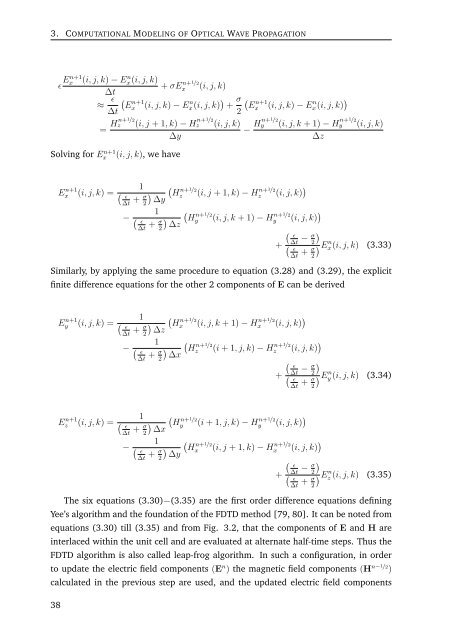Rahul Dewan - Jacobs University
Rahul Dewan - Jacobs University
Rahul Dewan - Jacobs University
Create successful ePaper yourself
Turn your PDF publications into a flip-book with our unique Google optimized e-Paper software.
3. COMPUTATIONAL MODELING OF OPTICAL WAVE PROPAGATION<br />
ɛ En+1 x (i, j, k) − Ex n (i, j, k)<br />
∆t<br />
≈<br />
ɛ ∆t<br />
+ σE n+ 1/2<br />
x (i, j, k)<br />
(<br />
E<br />
n+1<br />
x (i, j, k) − Ex n (i, j, k) ) + σ (<br />
E<br />
n+1<br />
x (i, j, k) − Ex n (i, j, k) )<br />
2<br />
= Hn+ 1/2<br />
z (i, j + 1, k) − H n+ 1/2<br />
z (i, j, k)<br />
− Hn+ 1/2<br />
y (i, j, k + 1) − H n+ 1/2<br />
y (i, j, k)<br />
∆y<br />
∆z<br />
Solving for Ex<br />
n+1 (i, j, k), we have<br />
E n+1<br />
x (i, j, k) =<br />
1<br />
( ɛ<br />
∆t + σ 2<br />
)<br />
∆y<br />
(<br />
H<br />
n+1/2<br />
z (i, j + 1, k) − H n+ 1/2<br />
z (i, j, k) )<br />
−<br />
1<br />
( ɛ<br />
∆t + σ 2<br />
)<br />
∆z<br />
(<br />
H<br />
n+1/2<br />
y (i, j, k + 1) − H n+ 1/2<br />
y (i, j, k) )<br />
( ɛ<br />
∆t − σ 2<br />
)<br />
+ ( ɛ + )E σ x n (i, j, k) (3.33)<br />
∆t 2<br />
Similarly, by applying the same procedure to equation (3.28) and (3.29), the explicit<br />
finite difference equations for the other 2 components of E can be derived<br />
E n+1<br />
y (i, j, k) =<br />
1<br />
( ɛ<br />
∆t + σ 2<br />
)<br />
∆z<br />
(<br />
H<br />
n+1/2<br />
x (i, j, k + 1) − H n+ 1/2<br />
x (i, j, k) )<br />
−<br />
1<br />
( ɛ<br />
∆t + σ 2<br />
)<br />
∆x<br />
(<br />
H<br />
n+1/2<br />
z (i + 1, j, k) − H n+ 1/2<br />
z (i, j, k) )<br />
( ɛ<br />
∆t − σ 2<br />
)<br />
+ ( ɛ + )E σ y n (i, j, k) (3.34)<br />
∆t 2<br />
E n+1<br />
z (i, j, k) =<br />
1<br />
( ɛ<br />
∆t + σ 2<br />
)<br />
∆x<br />
(<br />
H<br />
n+1/2<br />
y (i + 1, j, k) − H n+ 1/2<br />
y (i, j, k) )<br />
−<br />
1<br />
( ɛ<br />
∆t + σ 2<br />
)<br />
∆y<br />
(<br />
H<br />
n+1/2<br />
x (i, j + 1, k) − H n+ 1/2<br />
x (i, j, k) )<br />
( ɛ<br />
∆t − σ 2<br />
)<br />
+ ( ɛ + )E σ z n (i, j, k) (3.35)<br />
∆t 2<br />
The six equations (3.30)−(3.35) are the first order difference equations defining<br />
Yee’s algorithm and the foundation of the FDTD method [79, 80]. It can be noted from<br />
equations (3.30) till (3.35) and from Fig. 3.2, that the components of E and H are<br />
interlaced within the unit cell and are evaluated at alternate half-time steps. Thus the<br />
FDTD algorithm is also called leap-frog algorithm. In such a configuration, in order<br />
to update the electric field components (E n ) the magnetic field components (H n− 1/2<br />
)<br />
calculated in the previous step are used, and the updated electric field components<br />
38

















